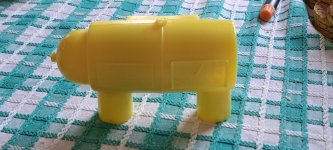Was out for a walk and found this left behind after some roadwork by the local energy company.
When I'd got it home I realised what was going on and thought it was pretty cool.
Or hot, unless you leave it a minute to cool...
When I'd got it home I realised what was going on and thought it was pretty cool.
Or hot, unless you leave it a minute to cool...
Attachments
Now there's a controls nightmare, if 6 turned out to be 9 as Jimi said. "How many miles with that box did you do?"
A ring heater is the normal way to join HDPE gas pipes, it is one of the really difficult materials to glue.
Or sometimes a 'mirror' is used, again a type of heater.
Can't take chances with gas.
That goes for other HDPE, LDPE, PP and many Nylon grades as well.
Even for printing, you have to prepare the surface using high voltage discharge, flame, hot air and other methods, sometimes the effect is temporary, the printing has to be done within minutes, or the ink will not ahere.
That is not an audio subject, however...
Or sometimes a 'mirror' is used, again a type of heater.
Can't take chances with gas.
That goes for other HDPE, LDPE, PP and many Nylon grades as well.
Even for printing, you have to prepare the surface using high voltage discharge, flame, hot air and other methods, sometimes the effect is temporary, the printing has to be done within minutes, or the ink will not ahere.
That is not an audio subject, however...
Last edited:
Yes. But it's fascinating. The chain of technology that has to be in place before something as 'mundane' as providing a gas tight joint can be done quickly, reliably, and cheaply.That is not an audio subject, however...
It starts in an oil refinery, ethylene is sent from there to make polyethylene at a petrochemical plant, then the material is processed to get pipe and fittings.
And of course an oil well has to be drilled, the oil extracted, then sent to a refinery.
Very interesting, also important to remember how we take mundane things like house gas for granted.
I wonder if the protesters in Germany, who are using paint, actually realize it is made from petroleum products (some green supporters), it seems they are protesting against oil refining!.
And of course an oil well has to be drilled, the oil extracted, then sent to a refinery.
Very interesting, also important to remember how we take mundane things like house gas for granted.
I wonder if the protesters in Germany, who are using paint, actually realize it is made from petroleum products (some green supporters), it seems they are protesting against oil refining!.
In my experience, no. For example, many many years ago I went to a party where a guy in high end motorbike leathers held forth on the evils of modern technology. Blissfully unaware that his motorbike, leathers and helmet embodied the things he was complaining so much about.I wonder if the protesters in Germany, who are using paint, actually realize
Indeed. Same for the glue they use. The rubber in their cycle tires.
We had (one of) our "green" ministers take a cab during the "carless sunday" to go to the television studio to explain why we need to go green. Her excuse was that cycling 8km (when there are no car in the city) was too complicated. Yep, green all the way.
We had (one of) our "green" ministers take a cab during the "carless sunday" to go to the television studio to explain why we need to go green. Her excuse was that cycling 8km (when there are no car in the city) was too complicated. Yep, green all the way.
I used to work for a pipe fusion company.
I worked on one of their fusion machines after the designer left.
They complained in the factory that they couldnt get the resistor value reliably from inside the couplings for the amount of power needed to fuse the joint.
A quick look at their front end showed someone had attempted a differential input but failed miserably.
A quick swap around of 2 components and all the noise was gone.
The big motors and machinery in the factory were generating massive amounts of interference.
I worked on one of their fusion machines after the designer left.
They complained in the factory that they couldnt get the resistor value reliably from inside the couplings for the amount of power needed to fuse the joint.
A quick look at their front end showed someone had attempted a differential input but failed miserably.
A quick swap around of 2 components and all the noise was gone.
The big motors and machinery in the factory were generating massive amounts of interference.
I don't, not lived in a house with gas since 2003Very interesting, also important to remember how we take mundane things like house gas for granted.
I did a heating system where a measured temperature was needed from the (copper) winding resistance itself. Measured the voltage drop from a small applied current in between the PWM pulses providing the heater power. Lucky for me the PWM frequency was so slow; there was plenty of time for the measurement amp to come out of saturation before I sampled its output.they couldnt get the resistor value reliably from inside the couplings for the amount of power needed to fuse the joint.
Gas free since 1990 here!I don't, not lived in a house with gas since 2003
I'm impressed though, that you can buy 100% renewably sourced electricity - the tech involved in getting just those electrons to your house must be impressive...
- Home
- Member Areas
- The Lounge
- How to glue your gas pipes without glue...


